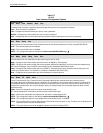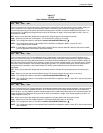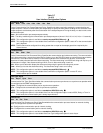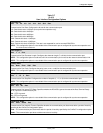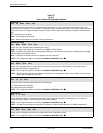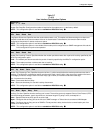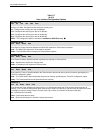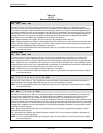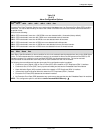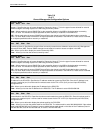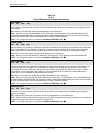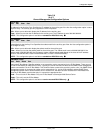
ACCULINK 316x DSU/CSU
C-26 January 1997 3160-A2-GB21-50
Table C-8
(2 of 3)
Alarm Configuration Options
DialOut: Disab
Next Enab Disab Prev
Alarm and Trap Dial Out. Controls whether generated alarm or trap messages initiate a call if the integral modem
connection or carrier external communication port device connection has not already been established. When enabled, a
call is placed to the phone number contained in the alarm directory (directory A). If the call cannot be completed and the
retry option is enabled, the alarm or trap message is held until the call is completed or the maximum (five) retry count has
been exceeded. If more than one alarm message is received while waiting for a call retry, only the highest priority alarm
message received is held; all previous messages are discarded. When the modem port is configured as the SNMP
management link, up to 10 SNMP trap messages can be queued at the interface.
Enab – Enables automatic call initiation (dial out) if an alarm or trap message needs to be sent.
Disab – Disables automatic call initiation. Trap messages sent to the modem port or carrier external communication port
device are queued (held) if an integral modem connection or carrier external communication port device connection has
not been previously established. Alarm messages are not queued.
NOTE: For carrier-mounted DSU/CSUs, this configuration option is only available if the communication port is enabled
for an external device.
Call Retry: Disab
Next Enab Disab Prev
Call Retry on Alarm or Trap. Determines whether a call that cannot complete (busy, no answer, etc.) is retried. This
affects calls that are initiated in attempting to send an alarm or trap message to the modem port or carrier external
communication port device. If call retry is specified, the DSU/CSU attempts to complete the call after a configurable delay.
Enab – Enables call retry. If enabled the call is retried up to a maximum of five times per alarm or trap message. A delay
as specified by the dial-out delay time is imposed between call attempts. If an alternate dial-out directory is specified, both
the alarm directory as well as the alternate directory are retried up to five times.
Disab – Disables call retry. If a call setup cannot be completed it is not retried.
NOTE: For carrier-mounted DSU/CSUs, this configuration option is only available if the communication port is enabled
for an external device.
Dial Delay: 5
Next 1 2 3 4 5 6 7 8 9 10 Prev
Dial Out Delay Time on Alarm or Trap. Specifies the number of minutes to wait between successive dial-out alarms or
traps and between retry attempts after failed alarm dial-outs. The factory default is 5 minutes.
NOTE: For carrier-mounted DSU/CSUs, this configuration option is only available if the communication port is enabled
for an external device.
AltDialDir: None
Next None 1 2 3 4 5 Prev
Alternate Dial-Out Directory for Alarm or Trap. Specifies whether a call that cannot be completed (busy, no answer, etc.)
is retried using an alternate phone number. This affects calls that are initiated in an attempt to send an alarm or trap
message to the modem port or carrier external communication port device. The alternate phone number to try is
contained in one of the five call directories. If call retry is enabled, the initial call is retried at the original number five times
before a call attempt to the alternate number is tried. If the call does not complete at the alternate number, it is also retried
up to the five-retry maximum. The alternate dial-out option applies to each alarm/trap event. Once a call for an alarm/trap
message either completes or fails all retry attempts, the next alarm/trap attempts to establish a call to the phone number
contained in the alarm directory.
None – Specifies that alternate alarm dial-out is not performed if a call cannot be completed to the telephone number
contained in the alarm directory.
1–5 – Specifies the call directory that contains the phone number to call if a call cannot be completed to the telephone
number contained in the alarm directory.
NOTE: For carrier-mounted DSU/CSUs, this configuration option is only available if the communication port is enabled
for an external device.



